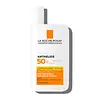What's inside
What's inside
 Key Ingredients
Key Ingredients

No key ingredients
 Benefits
Benefits

 Concerns
Concerns

 Ingredients Side-by-side
Ingredients Side-by-side

Drometrizole Trisiloxane 7%
UV AbsorberBis-Ethylhexyloxyphenol Methoxyphenyl Triazine 5%
Skin ConditioningEthylhexyl Salicylate 5%
UV AbsorberOctocrylene 5%
UV AbsorberButyl Methoxydibenzoylmethane 3%
UV AbsorberHomosalate 2%
Skin ConditioningPhenylbenzimidazole Sulfonic Acid 0.5%
UV AbsorberWater
Skin ConditioningAlcohol Denat.
AntimicrobialSilica
AbrasiveIsopropyl Myristate
EmollientGlycerin
HumectantDiisopropyl Sebacate
EmollientC12-22 Alkyl Acrylate/Hydroxyethylacrylate Copolymer
StabilisingPropanediol
SolventPerlite
AbsorbentTocopherol
AntioxidantTriethanolamine
BufferingCaprylyl Glycol
EmollientTrisodium Ethylenediamine Disuccinate
Disodium EDTA
Hydroxyethylcellulose
Emulsion StabilisingAcrylates/C10-30 Alkyl Acrylate Crosspolymer
Emulsion StabilisingDrometrizole Trisiloxane 7%, Bis-Ethylhexyloxyphenol Methoxyphenyl Triazine 5%, Ethylhexyl Salicylate 5%, Octocrylene 5%, Butyl Methoxydibenzoylmethane 3%, Homosalate 2%, Phenylbenzimidazole Sulfonic Acid 0.5%, Water, Alcohol Denat., Silica, Isopropyl Myristate, Glycerin, Diisopropyl Sebacate, C12-22 Alkyl Acrylate/Hydroxyethylacrylate Copolymer, Propanediol, Perlite, Tocopherol, Triethanolamine, Caprylyl Glycol, Trisodium Ethylenediamine Disuccinate, Disodium EDTA, Hydroxyethylcellulose, Acrylates/C10-30 Alkyl Acrylate Crosspolymer
Water
Skin ConditioningGlycerin
HumectantTapioca Starch
Butylene Glycol
HumectantCetyl Alcohol
EmollientHydrogenated Coco-Glycerides
EmollientMyristyl Myristate
EmollientStearyl Alcohol
EmollientPalmitic Acid
EmollientGlyceryl Stearate
EmollientStearic Acid
CleansingGlycyrrhiza Inflata Root Extract
Skin ConditioningDimethicone
Emollient1,2-Hexanediol
Skin ConditioningPhenoxyethanol
PreservativeSilica Dimethyl Silylate
EmollientDecylene Glycol
Skin ConditioningAcrylates/C10-30 Alkyl Acrylate Crosspolymer
Emulsion StabilisingBenzyl Alcohol
PerfumingXanthan Gum
EmulsifyingSodium Hydroxide
BufferingTrisodium EDTA
Water, Glycerin, Tapioca Starch, Butylene Glycol, Cetyl Alcohol, Hydrogenated Coco-Glycerides, Myristyl Myristate, Stearyl Alcohol, Palmitic Acid, Glyceryl Stearate, Stearic Acid, Glycyrrhiza Inflata Root Extract, Dimethicone, 1,2-Hexanediol, Phenoxyethanol, Silica Dimethyl Silylate, Decylene Glycol, Acrylates/C10-30 Alkyl Acrylate Crosspolymer, Benzyl Alcohol, Xanthan Gum, Sodium Hydroxide, Trisodium EDTA
 Reviews
Reviews

Ingredients Explained
These ingredients are found in both products.
Ingredients higher up in an ingredient list are typically present in a larger amount.
Acrylates/C10-30 Alkyl Acrylate Crosspolymer is a synthetic polymer. It is used to thicken and improve the texture of products. Due to its properties, it can prevent water and oil ingredients from separating.
Glycerin is already naturally found in your skin. It helps moisturize and protect your skin.
A study from 2016 found glycerin to be more effective as a humectant than AHAs and hyaluronic acid.
As a humectant, it helps the skin stay hydrated by pulling moisture to your skin. The low molecular weight of glycerin allows it to pull moisture into the deeper layers of your skin.
Hydrated skin improves your skin barrier; Your skin barrier helps protect against irritants and bacteria.
Glycerin has also been found to have antimicrobial and antiviral properties. Due to these properties, glycerin is often used in wound and burn treatments.
In cosmetics, glycerin is usually derived from plants such as soybean or palm. However, it can also be sourced from animals, such as tallow or animal fat.
This ingredient is organic, colorless, odorless, and non-toxic.
Glycerin is the name for this ingredient in American English. British English uses Glycerol/Glycerine.
Learn more about GlycerinWater. It's the most common cosmetic ingredient of all. You'll usually see it at the top of ingredient lists, meaning that it makes up the largest part of the product.
So why is it so popular? Water most often acts as a solvent - this means that it helps dissolve other ingredients into the formulation.
You'll also recognize water as that liquid we all need to stay alive. If you see this, drink a glass of water. Stay hydrated!
Learn more about Water